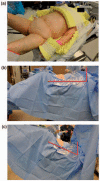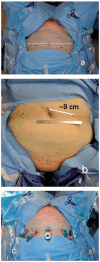Robotic-assisted laparoscopic mesh sacrocolpopexy
- PMID: 21789075
- PMCID: PMC3126084
- DOI: 10.1177/1756287210379120
Robotic-assisted laparoscopic mesh sacrocolpopexy
Abstract
The current 'gold standard' surgical repair for apical prolapse is the abdominal mesh sacrocolpopexy. Use of a robotic-assisted laparoscopic surgical approach has been demonstrated to be feasible as a minimally invasive approach and is gaining popularity amongst pelvic floor reconstructive surgeons. Although outcome data for robotic-assisted sacrocolpopexy (RASC) is only just emerging, several small series have demonstrated anatomic and functional outcomes, as well as complication rates, comparable to those reported for open surgery. The primary advantages thus far for RASC over open surgery include decreased blood loss and shorter hospital stay.
Keywords: mesh sacrocolpopexy; pelvic prolapse; robotic surgery.
Figures






Similar articles
-
Robotic sacrocolpopexy.Indian J Urol. 2014 Jul;30(3):318-25. doi: 10.4103/0970-1591.128502. Indian J Urol. 2014. PMID: 25097320 Free PMC article.
-
Abdominal approaches to pelvic prolapse repairs.Curr Opin Urol. 2013 Jul;23(4):306-11. doi: 10.1097/MOU.0b013e3283619e36. Curr Opin Urol. 2013. PMID: 23673511 Review.
-
Robotic laparoendoscopic single-site compared with robotic multi-port sacrocolpopexy for apical compartment prolapse.Am J Obstet Gynecol. 2020 Apr;222(4):358.e1-358.e11. doi: 10.1016/j.ajog.2019.09.048. Epub 2019 Oct 4. Am J Obstet Gynecol. 2020. PMID: 31589864 Clinical Trial.
-
Minimally invasive sacrocolpopexy: efficiency of robotic assistance compared to standard laparoscopy.J Robot Surg. 2024 Feb 10;18(1):72. doi: 10.1007/s11701-023-01799-1. J Robot Surg. 2024. PMID: 38340232 Free PMC article.
-
Robotic approaches to prolapse surgery.Curr Opin Urol. 2012 Jul;22(4):292-6. doi: 10.1097/MOU.0b013e328354809c. Curr Opin Urol. 2012. PMID: 22647648 Review.
Cited by
-
Long-term outcomes of robotic mesh sacrocolpopexy.J Robot Surg. 2018 Sep;12(3):455-460. doi: 10.1007/s11701-017-0757-2. Epub 2017 Oct 4. J Robot Surg. 2018. PMID: 28980173
-
Surgical Outcomes of a Combined Surgical Approach for Apical Prolapse Repair.Rev Bras Ginecol Obstet. 2016 Aug;38(8):405-11. doi: 10.1055/s-0036-1586747. Epub 2016 Aug 29. Rev Bras Ginecol Obstet. 2016. PMID: 27571384 Free PMC article.
-
The impact of training residents on the outcome of robotic-assisted sacrocolpopexy.Minim Invasive Surg. 2012;2012:289342. doi: 10.1155/2012/289342. Epub 2012 Nov 1. Minim Invasive Surg. 2012. PMID: 23209891 Free PMC article.
-
Chronic Pelvic Pain, Quality of Life, and Patient Satisfaction After Robotic Sacrocolpopexy for Pelvic Organ Prolapse.Cureus. 2022 Aug 17;14(8):e28095. doi: 10.7759/cureus.28095. eCollection 2022 Aug. Cureus. 2022. PMID: 36127971 Free PMC article.
-
Robot-assisted surgery:--impact on gynaecological and pelvic floor reconstructive surgery.Int Urogynecol J. 2012 Sep;23(9):1163-73. doi: 10.1007/s00192-012-1790-3. Epub 2012 May 26. Int Urogynecol J. 2012. PMID: 22638668 Review.
References
-
- Addison W.A., Timmons M.C. (1993) Abdominal approach to vaginal eversion. Clin Obstet Gynecol 36: 995–1004 - PubMed
-
- Addison W.A., Timmons M.C., Wall L.L., Livengood C.H., III (1989) Failed abdominal sacral colpopexy: observations and recommendations. Obstet Gynecol 74: 480–483 - PubMed
-
- Akl M.N., Long J.B., Giles D.L., Cornella J.L., Pettit P.D., Chen A.H., et al. (2009) Robotic-assisted sacrocolpopexy: technique and learning curve. Surg Endosc 23: 2390–2394 - PubMed
-
- Akladios C.Y., Dautun D., Saussine C., Baldauf J.J., Mathelin C., Wattiez A. (2010) Laparoscopic sacrocolpopexy for female genital organ prolapse: establishment of a learning curve. Eur J Obstet Gynecol Reproductive Biol 149: 218–221 - PubMed
-
- Antiphon P., Elard S., Benyoussef A., Fofana M., Yiou R., Gettman M., et al. (2004) Laparoscopic promontory sacral colpopexy: is the posterior, recto-vaginal, mesh mandatory? Eur Urol 45: 655–661 - PubMed
LinkOut - more resources
Full Text Sources

